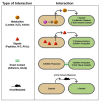Clinical Implications of Polymicrobial Synergism Effects on Antimicrobial Susceptibility
- PMID: 33535562
- PMCID: PMC7912749
- DOI: 10.3390/pathogens10020144
Clinical Implications of Polymicrobial Synergism Effects on Antimicrobial Susceptibility
Abstract
With the development of next generation sequencing technologies in recent years, it has been demonstrated that many human infectious processes, including chronic wounds, cystic fibrosis, and otitis media, are associated with a polymicrobial burden. Research has also demonstrated that polymicrobial infections tend to be associated with treatment failure and worse patient prognoses. Despite the importance of the polymicrobial nature of many infection states, the current clinical standard for determining antimicrobial susceptibility in the clinical laboratory is exclusively performed on unimicrobial suspensions. There is a growing body of research demonstrating that microorganisms in a polymicrobial environment can synergize their activities associated with a variety of outcomes, including changes to their antimicrobial susceptibility through both resistance and tolerance mechanisms. This review highlights the current body of work describing polymicrobial synergism, both inter- and intra-kingdom, impacting antimicrobial susceptibility. Given the importance of polymicrobial synergism in the clinical environment, a new system of determining antimicrobial susceptibility from polymicrobial infections may significantly impact patient treatment and outcomes.
Keywords: antimicrobial susceptibility; clinical; diagnostics; interactions; polymicrobial; synergism.
Conflict of interest statement
The authors declare no conflict of interest.
Figures


References
-
- CLSI . Methods for Dilution Antimicrobial Susceptibility Tests for Bacteria That Grow Aerobically. 11th ed. CLSI; Wayne, PA, USA: 2018.
-
- Cummings L.A., Hoogestraat D.R., Rassoulian-Barrett S.L., Rosenthal C.A., Salipante S.J., Cookson B.T., Hoffman N.G. Comprehensive evaluation of complex polymicrobial specimens using next generation sequencing and standard microbiological culture. Sci. Rep. 2020;10:5446. doi: 10.1038/s41598-020-62424-x. - DOI - PMC - PubMed
Publication types
LinkOut - more resources
Full Text Sources
Other Literature Sources

